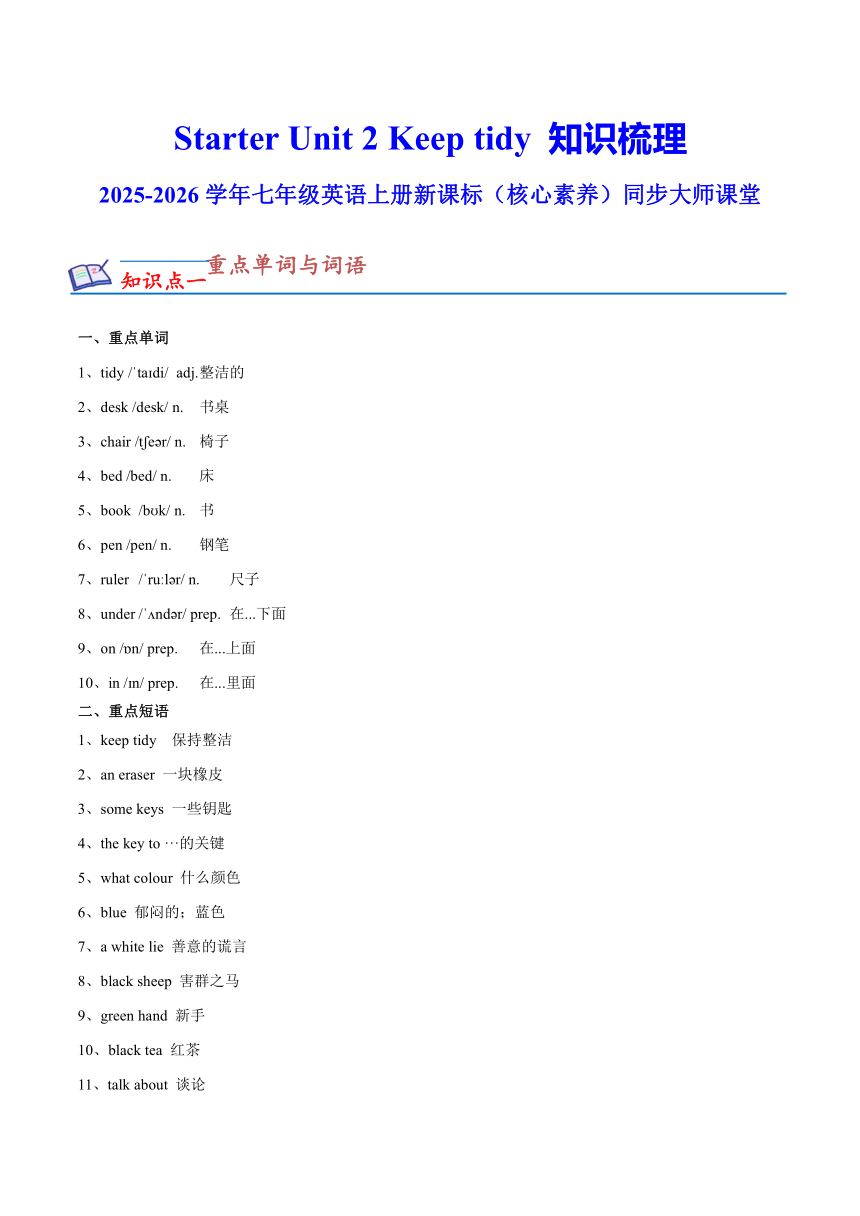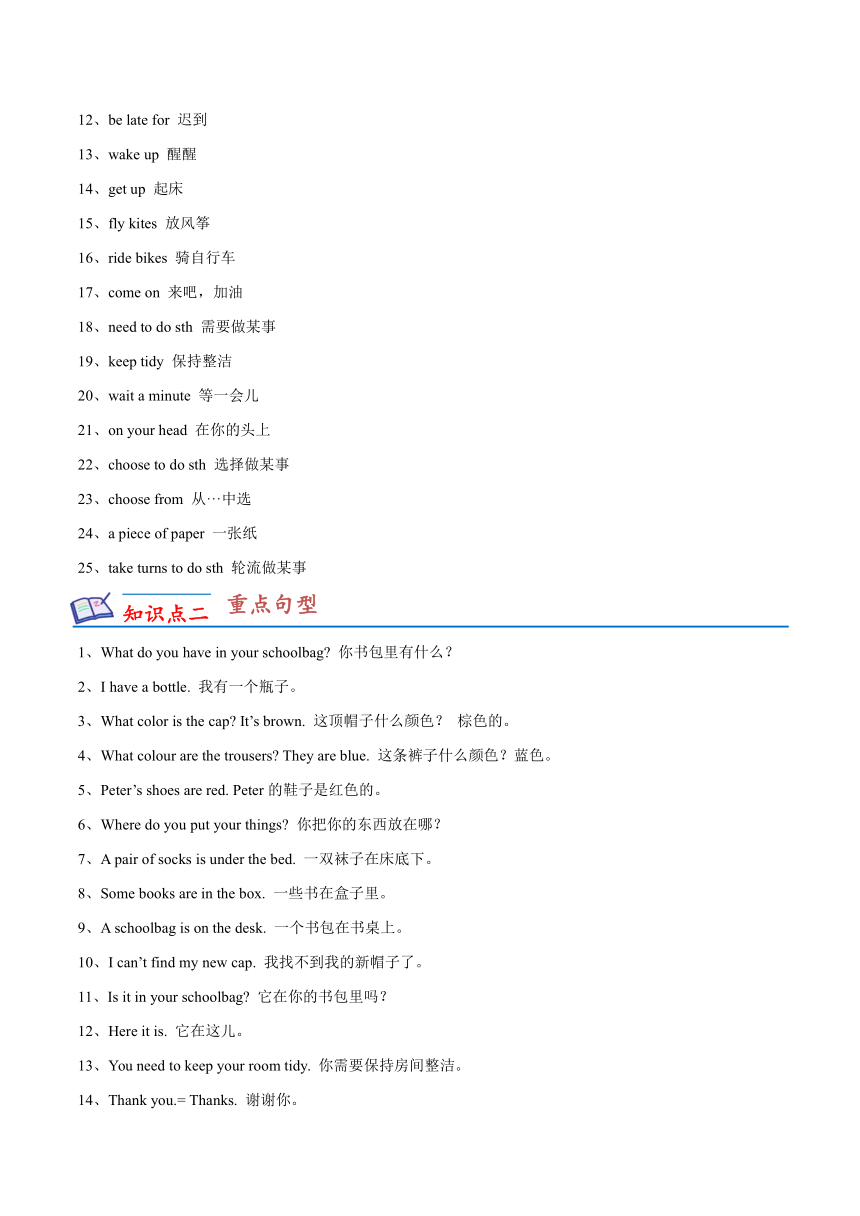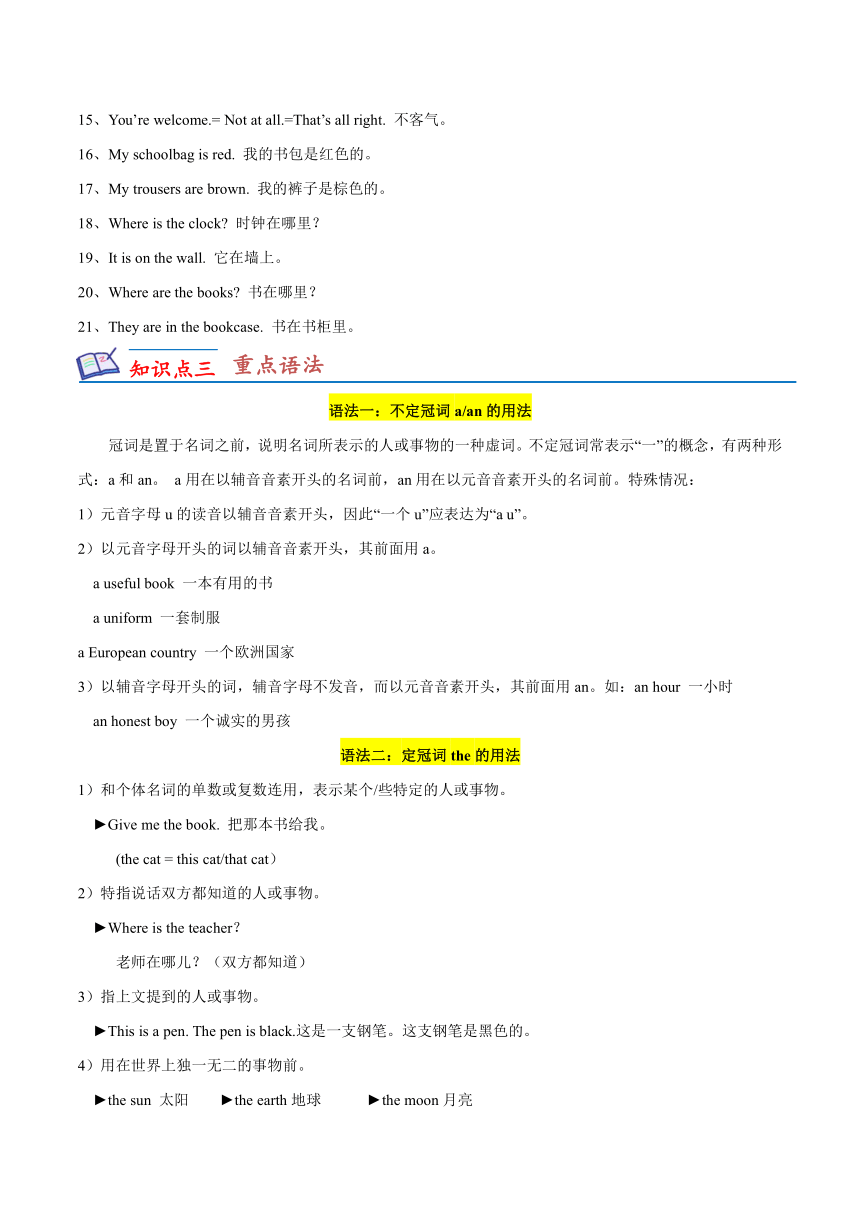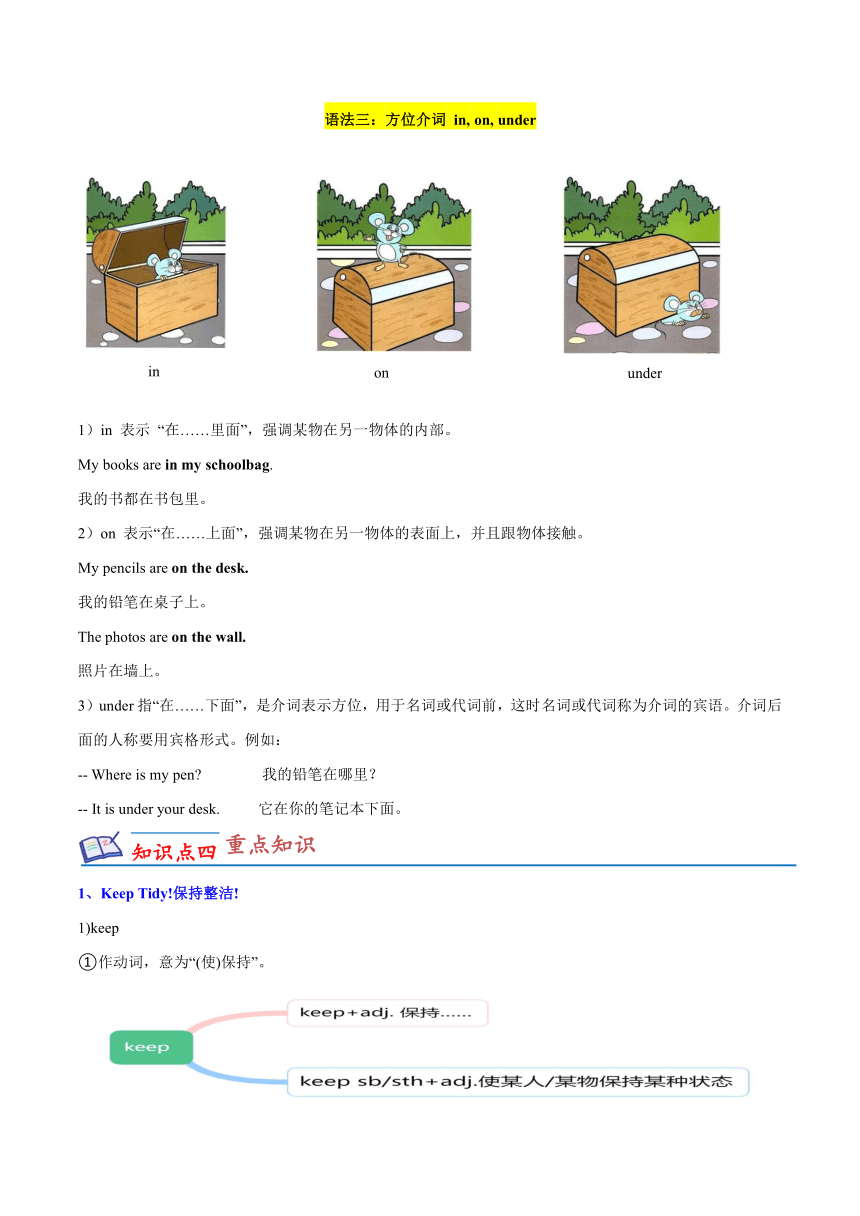Starter Unit 2 Keep tidy 知识梳理-2025-2026学年七年级英语上册新课标(核心素养)同步大师课堂(人教版2024)
文档属性
| 名称 | Starter Unit 2 Keep tidy 知识梳理-2025-2026学年七年级英语上册新课标(核心素养)同步大师课堂(人教版2024) |  | |
| 格式 | docx | ||
| 文件大小 | 377.7KB | ||
| 资源类型 | 教案 | ||
| 版本资源 | 人教版 | ||
| 科目 | 英语 | ||
| 更新时间 | 2025-07-16 10:33:18 | ||
图片预览




文档简介
Starter Unit 2 Keep tidy 知识梳理
2025-2026学年七年级英语上册新课标(核心素养)同步大师课堂
(
重点单词与词语
) (
知识点一
)
一、重点单词
1、tidy / ta di/ adj. 整洁的
2、desk /desk/ n. 书桌
3、chair /t e r/ n. 椅子
4、bed /bed/ n. 床
5、book /b k/ n. 书
6、pen /pen/ n. 钢笔
7、ruler / ru l r/ n. 尺子
8、under / nd r/ prep. 在...下面
9、on / n/ prep. 在...上面
10、in / n/ prep. 在...里面
二、重点短语
1、keep tidy 保持整洁
2、an eraser 一块橡皮
3、some keys 一些钥匙
4、the key to ···的关键
5、what colour 什么颜色
6、blue 郁闷的;蓝色
7、a white lie 善意的谎言
8、black sheep 害群之马
9、green hand 新手
10、black tea 红茶
11、talk about 谈论
12、be late for 迟到
13、wake up 醒醒
14、get up 起床
15、fly kites 放风筝
16、ride bikes 骑自行车
17、come on 来吧,加油
18、need to do sth 需要做某事
19、keep tidy 保持整洁
20、wait a minute 等一会儿
21、on your head 在你的头上
22、choose to do sth 选择做某事
23、choose from 从···中选
24、a piece of paper 一张纸
(
重点句型
)25、take turns to do sth 轮流做某事
(
知识点二
)
1、What do you have in your schoolbag 你书包里有什么?
2、I have a bottle. 我有一个瓶子。
3、What color is the cap It’s brown. 这顶帽子什么颜色? 棕色的。
4、What colour are the trousers They are blue. 这条裤子什么颜色?蓝色。
5、Peter’s shoes are red. Peter的鞋子是红色的。
6、Where do you put your things 你把你的东西放在哪?
7、A pair of socks is under the bed. 一双袜子在床底下。
8、Some books are in the box. 一些书在盒子里。
9、A schoolbag is on the desk. 一个书包在书桌上。
10、I can’t find my new cap. 我找不到我的新帽子了。
11、Is it in your schoolbag 它在你的书包里吗?
12、Here it is. 它在这儿。
13、You need to keep your room tidy. 你需要保持房间整洁。
14、Thank you.= Thanks. 谢谢你。
15、You’re welcome.= Not at all.=That’s all right. 不客气。
16、My schoolbag is red. 我的书包是红色的。
17、My trousers are brown. 我的裤子是棕色的。
18、Where is the clock 时钟在哪里?
19、It is on the wall. 它在墙上。
20、Where are the books 书在哪里?
(
重点语法
)21、They are in the bookcase. 书在书柜里。
(
知识点三
)
语法一:不定冠词a/an的用法
冠词是置于名词之前,说明名词所表示的人或事物的一种虚词。不定冠词常表示“一”的概念,有两种形式:a和an。 a用在以辅音音素开头的名词前,an用在以元音音素开头的名词前。特殊情况:
1)元音字母u的读音以辅音音素开头,因此“一个u”应表达为“a u”。
2)以元音字母开头的词以辅音音素开头,其前面用a。
a useful book 一本有用的书
a uniform 一套制服
a European country 一个欧洲国家
3)以辅音字母开头的词,辅音字母不发音,而以元音音素开头,其前面用an。如:an hour 一小时
an honest boy 一个诚实的男孩
语法二:定冠词the的用法
1)和个体名词的单数或复数连用,表示某个/些特定的人或事物。
Give me the book. 把那本书给我。
(the cat = this cat/that cat)
2)特指说话双方都知道的人或事物。
Where is the teacher?
老师在哪儿?(双方都知道)
3)指上文提到的人或事物。
This is a pen. The pen is black.这是一支钢笔。这支钢笔是黑色的。
4)用在世界上独一无二的事物前。
the sun 太阳 the earth地球 the moon月亮
语法三:方位介词 in, on, under
(
under
) (
in
) (
on
)
1)in 表示 “在……里面”,强调某物在另一物体的内部。
My books are in my schoolbag.
我的书都在书包里。
2)on 表示“在……上面”,强调某物在另一物体的表面上,并且跟物体接触。
My pencils are on the desk.
我的铅笔在桌子上。
The photos are on the wall.
照片在墙上。
3)under指“在……下面”,是介词表示方位,用于名词或代词前,这时名词或代词称为介词的宾语。介词后面的人称要用宾格形式。例如:
-- Where is my pen 我的铅笔在哪里?
-- It is under your desk. (
重点知识
) 它在你的笔记本下面。
(
知识点四
)
1、Keep Tidy!保持整洁!
1)keep
①作动词,意为“(使)保持”。
To keep cool, he keeps the door open.
为了保持凉爽,他开着门。
②作动词,还可意为“保留”。常用
【搭配】keep sth 保留某物
I keep all her books.我保留着她所有的书。
2)tidy作形容词,意为“整洁的;井井有条的”,反义词为untidy。既可放在系动词后作表语,又可放在名词前作定语。
keep tidy 保持整洁 a tidy room 一个整洁的房间
【拓展】tidy作动词,意为“使整洁”。 tidy up 收拾妥;整理好
2、What do you have in your school-bag 你的书包里有什么
“What do you have+地点状语 ”是一个特殊疑问句,用于询问对方有什么物品。答语通常为“I have ...”。
—What do you have in your bag
你的包里有什么
—Some books.
一些书。
【拓展】当主语为第三人称单数he/she/it等时,助动词用does,答语通常为“主语+has .…”。
—What does Tom have on his desk
汤姆的桌子上有什么
—He has an eraser and a book.
他有一块橡皮和一本书。
3、I have a bottle.我有一个瓶子。
bottle作名词,意为“瓶子”。
a beer/milk/water bottle一个啤酒/牛奶/水瓶
a plastic/glass bottle一个塑料/玻璃瓶
There is some water in the bottle.瓶子里有些水。
【拓展】bottle还可意为“一瓶(的量)”。
I need a bottle of milk.
我需要一瓶牛奶。
4、What colour is the cap 帽子是什么颜色的
“What colour+be动词+主语 ”是询问物品颜色的特殊疑问句,其同义表达为“What+be 动词+the colour of ... ”。
主语的形式 Be的形式 答语
当句子的主语是单数名词、不可数名词或第三人称单数代词时 be动词用is (It's+)表示颜色的形容词. —What colour is the jacket 这件夹克衫是什么颜色的 —It's blue.它是蓝色的。
当句子的主语是复数名词或复数人称代词时 be动词用are (They're+)表示颜色的形容词. —What colour are the clothes 这些衣服是什么颜色的 —They're red and blue.它们是红蓝相间的。
5、What colors are the trousers 裤子是什么颜色的
1)trousers 指长裤,通常用复数形式。 a pair of trousers一条裤子
①trousers作主语时,谓语动词用复数形式。
Li Ming's trousers are cool.
李明的裤子很酷。
②a pair of trousers作主语时,谓语动词用单数形式。
A pair of trousers is on the bed.
床上有一条裤子。
【拓展】与 trousers 用法类似的复数名词还有:shoes(鞋)、socks(短袜)、shorts(短裤)、glasses
(眼镜)、scissors(剪刀)
6、Teng Fei's schoolbag is blue.滕飞的书包是蓝色的。
“人名+'s”是一种名词所有格形式,表示“某人的”。通常用在名词前作定语,或用在系动词(如be动词)后作表语。
This is Tom's cup.
这是汤姆的杯子。
These books are John's.
这些书是约翰的。
7、Where do you put your things 你把东西放在哪里
1)“Where do you put+被询问的物品 ”是一个where 引导的特殊疑问句,用于询问对方把某物放在哪里,回答时常用表示方位的介词短语。当主语是第三人称单数时,助动词用does.
—Where do you put the apples
你把苹果放哪里了
—I put them on the plate.
我把它们放盘子上了。
—Where does Dad put the basketball
爸爸把篮球放哪里了
—Under the bed.
在床底下。
2)put为动词,意为“放”。后接名词或代词作宾语。
I put my schoolbag on the chair.
我把我的书包放在了椅子上。
【拓展】
8、A schoolbag is on the desk.一个书包在桌子上。
Some books are in the box.
一些书在盒子里。
A pair of socks is under the bed.
一双短袜在床下。
1)方位介词on、in、under的区别如下:
on 在……上 一个物体在另一个物体的表面上,且两者之间有接触
in 在……里 一个物体在另一个物体或某一空间的内部
under 在……下 一个物体在另一个物体的下方,两者之间可以有接触,也可以没有
2)“a pair of+复数名词”作主语时动词要与 pair保持一致,用单数形式。其中不定冠词a可换成this、that等。
I want a pair of basketball shoes.
我想要一双篮球鞋。
This pair of shoes is nice.
这双鞋很好。
3)“..pairs of+复数名词”表示“……双/
对……”,当它作主语时,谓语动词要与 pairs保持一致,用复数形式。
Two pairs of gloves are on the table.
桌子上有两副手套。
9、Mum, I can't find my new cap.妈妈,我找不到我的新帽子。
find作动词,意为“找到;发现”
find 与look for的区别如下:
find意为“找到;发现”,强调“找到”这一结果
look for意为“寻找”,强调“寻找”这一动作,但不不可一定能找到
My mother looked for her keys everywhere, but she didn't find them.
我妈妈到处找她的钥匙,但是没找到。
10、Oh, here it is.哦,在这里呢。
1)此句型用于找到某物时,意为“在这里呢”。
—Do you see my eraser
你看见我的橡皮了吗
—Oh, here it is.
哦,在这里呢。
2)用于把某物给某人时,意为“给你”。此时相当于here you are。
—Can you pass me the book
你能把书递给我一下吗
—Sure, here it is/you are.
好,给你。
11、You need to keep your room tidy.你需要保持房间整洁。
12、No, I don't see them.不,我没看到它们。
see作动词,意为“看见”。see、look与watch 的用法区别如下:
see:强调“看”的结果。也可用于一些短语中。see a doctor看医生see a movie看电影
look:强调“看”的动作。单独使用时,用来引起对方的注意;后接宾语时,要和at连用
watch:强调专注地“看”,有观赏的意味,常用于看电视、看球赛、看表演等
Look at the boy over there. He likes watching TV and seeing movies.
看那边的那个男孩。他喜欢看电视和看电影。
2025-2026学年七年级英语上册新课标(核心素养)同步大师课堂
(
重点单词与词语
) (
知识点一
)
一、重点单词
1、tidy / ta di/ adj. 整洁的
2、desk /desk/ n. 书桌
3、chair /t e r/ n. 椅子
4、bed /bed/ n. 床
5、book /b k/ n. 书
6、pen /pen/ n. 钢笔
7、ruler / ru l r/ n. 尺子
8、under / nd r/ prep. 在...下面
9、on / n/ prep. 在...上面
10、in / n/ prep. 在...里面
二、重点短语
1、keep tidy 保持整洁
2、an eraser 一块橡皮
3、some keys 一些钥匙
4、the key to ···的关键
5、what colour 什么颜色
6、blue 郁闷的;蓝色
7、a white lie 善意的谎言
8、black sheep 害群之马
9、green hand 新手
10、black tea 红茶
11、talk about 谈论
12、be late for 迟到
13、wake up 醒醒
14、get up 起床
15、fly kites 放风筝
16、ride bikes 骑自行车
17、come on 来吧,加油
18、need to do sth 需要做某事
19、keep tidy 保持整洁
20、wait a minute 等一会儿
21、on your head 在你的头上
22、choose to do sth 选择做某事
23、choose from 从···中选
24、a piece of paper 一张纸
(
重点句型
)25、take turns to do sth 轮流做某事
(
知识点二
)
1、What do you have in your schoolbag 你书包里有什么?
2、I have a bottle. 我有一个瓶子。
3、What color is the cap It’s brown. 这顶帽子什么颜色? 棕色的。
4、What colour are the trousers They are blue. 这条裤子什么颜色?蓝色。
5、Peter’s shoes are red. Peter的鞋子是红色的。
6、Where do you put your things 你把你的东西放在哪?
7、A pair of socks is under the bed. 一双袜子在床底下。
8、Some books are in the box. 一些书在盒子里。
9、A schoolbag is on the desk. 一个书包在书桌上。
10、I can’t find my new cap. 我找不到我的新帽子了。
11、Is it in your schoolbag 它在你的书包里吗?
12、Here it is. 它在这儿。
13、You need to keep your room tidy. 你需要保持房间整洁。
14、Thank you.= Thanks. 谢谢你。
15、You’re welcome.= Not at all.=That’s all right. 不客气。
16、My schoolbag is red. 我的书包是红色的。
17、My trousers are brown. 我的裤子是棕色的。
18、Where is the clock 时钟在哪里?
19、It is on the wall. 它在墙上。
20、Where are the books 书在哪里?
(
重点语法
)21、They are in the bookcase. 书在书柜里。
(
知识点三
)
语法一:不定冠词a/an的用法
冠词是置于名词之前,说明名词所表示的人或事物的一种虚词。不定冠词常表示“一”的概念,有两种形式:a和an。 a用在以辅音音素开头的名词前,an用在以元音音素开头的名词前。特殊情况:
1)元音字母u的读音以辅音音素开头,因此“一个u”应表达为“a u”。
2)以元音字母开头的词以辅音音素开头,其前面用a。
a useful book 一本有用的书
a uniform 一套制服
a European country 一个欧洲国家
3)以辅音字母开头的词,辅音字母不发音,而以元音音素开头,其前面用an。如:an hour 一小时
an honest boy 一个诚实的男孩
语法二:定冠词the的用法
1)和个体名词的单数或复数连用,表示某个/些特定的人或事物。
Give me the book. 把那本书给我。
(the cat = this cat/that cat)
2)特指说话双方都知道的人或事物。
Where is the teacher?
老师在哪儿?(双方都知道)
3)指上文提到的人或事物。
This is a pen. The pen is black.这是一支钢笔。这支钢笔是黑色的。
4)用在世界上独一无二的事物前。
the sun 太阳 the earth地球 the moon月亮
语法三:方位介词 in, on, under
(
under
) (
in
) (
on
)
1)in 表示 “在……里面”,强调某物在另一物体的内部。
My books are in my schoolbag.
我的书都在书包里。
2)on 表示“在……上面”,强调某物在另一物体的表面上,并且跟物体接触。
My pencils are on the desk.
我的铅笔在桌子上。
The photos are on the wall.
照片在墙上。
3)under指“在……下面”,是介词表示方位,用于名词或代词前,这时名词或代词称为介词的宾语。介词后面的人称要用宾格形式。例如:
-- Where is my pen 我的铅笔在哪里?
-- It is under your desk. (
重点知识
) 它在你的笔记本下面。
(
知识点四
)
1、Keep Tidy!保持整洁!
1)keep
①作动词,意为“(使)保持”。
To keep cool, he keeps the door open.
为了保持凉爽,他开着门。
②作动词,还可意为“保留”。常用
【搭配】keep sth 保留某物
I keep all her books.我保留着她所有的书。
2)tidy作形容词,意为“整洁的;井井有条的”,反义词为untidy。既可放在系动词后作表语,又可放在名词前作定语。
keep tidy 保持整洁 a tidy room 一个整洁的房间
【拓展】tidy作动词,意为“使整洁”。 tidy up 收拾妥;整理好
2、What do you have in your school-bag 你的书包里有什么
“What do you have+地点状语 ”是一个特殊疑问句,用于询问对方有什么物品。答语通常为“I have ...”。
—What do you have in your bag
你的包里有什么
—Some books.
一些书。
【拓展】当主语为第三人称单数he/she/it等时,助动词用does,答语通常为“主语+has .…”。
—What does Tom have on his desk
汤姆的桌子上有什么
—He has an eraser and a book.
他有一块橡皮和一本书。
3、I have a bottle.我有一个瓶子。
bottle作名词,意为“瓶子”。
a beer/milk/water bottle一个啤酒/牛奶/水瓶
a plastic/glass bottle一个塑料/玻璃瓶
There is some water in the bottle.瓶子里有些水。
【拓展】bottle还可意为“一瓶(的量)”。
I need a bottle of milk.
我需要一瓶牛奶。
4、What colour is the cap 帽子是什么颜色的
“What colour+be动词+主语 ”是询问物品颜色的特殊疑问句,其同义表达为“What+be 动词+the colour of ... ”。
主语的形式 Be的形式 答语
当句子的主语是单数名词、不可数名词或第三人称单数代词时 be动词用is (It's+)表示颜色的形容词. —What colour is the jacket 这件夹克衫是什么颜色的 —It's blue.它是蓝色的。
当句子的主语是复数名词或复数人称代词时 be动词用are (They're+)表示颜色的形容词. —What colour are the clothes 这些衣服是什么颜色的 —They're red and blue.它们是红蓝相间的。
5、What colors are the trousers 裤子是什么颜色的
1)trousers 指长裤,通常用复数形式。 a pair of trousers一条裤子
①trousers作主语时,谓语动词用复数形式。
Li Ming's trousers are cool.
李明的裤子很酷。
②a pair of trousers作主语时,谓语动词用单数形式。
A pair of trousers is on the bed.
床上有一条裤子。
【拓展】与 trousers 用法类似的复数名词还有:shoes(鞋)、socks(短袜)、shorts(短裤)、glasses
(眼镜)、scissors(剪刀)
6、Teng Fei's schoolbag is blue.滕飞的书包是蓝色的。
“人名+'s”是一种名词所有格形式,表示“某人的”。通常用在名词前作定语,或用在系动词(如be动词)后作表语。
This is Tom's cup.
这是汤姆的杯子。
These books are John's.
这些书是约翰的。
7、Where do you put your things 你把东西放在哪里
1)“Where do you put+被询问的物品 ”是一个where 引导的特殊疑问句,用于询问对方把某物放在哪里,回答时常用表示方位的介词短语。当主语是第三人称单数时,助动词用does.
—Where do you put the apples
你把苹果放哪里了
—I put them on the plate.
我把它们放盘子上了。
—Where does Dad put the basketball
爸爸把篮球放哪里了
—Under the bed.
在床底下。
2)put为动词,意为“放”。后接名词或代词作宾语。
I put my schoolbag on the chair.
我把我的书包放在了椅子上。
【拓展】
8、A schoolbag is on the desk.一个书包在桌子上。
Some books are in the box.
一些书在盒子里。
A pair of socks is under the bed.
一双短袜在床下。
1)方位介词on、in、under的区别如下:
on 在……上 一个物体在另一个物体的表面上,且两者之间有接触
in 在……里 一个物体在另一个物体或某一空间的内部
under 在……下 一个物体在另一个物体的下方,两者之间可以有接触,也可以没有
2)“a pair of+复数名词”作主语时动词要与 pair保持一致,用单数形式。其中不定冠词a可换成this、that等。
I want a pair of basketball shoes.
我想要一双篮球鞋。
This pair of shoes is nice.
这双鞋很好。
3)“..pairs of+复数名词”表示“……双/
对……”,当它作主语时,谓语动词要与 pairs保持一致,用复数形式。
Two pairs of gloves are on the table.
桌子上有两副手套。
9、Mum, I can't find my new cap.妈妈,我找不到我的新帽子。
find作动词,意为“找到;发现”
find 与look for的区别如下:
find意为“找到;发现”,强调“找到”这一结果
look for意为“寻找”,强调“寻找”这一动作,但不不可一定能找到
My mother looked for her keys everywhere, but she didn't find them.
我妈妈到处找她的钥匙,但是没找到。
10、Oh, here it is.哦,在这里呢。
1)此句型用于找到某物时,意为“在这里呢”。
—Do you see my eraser
你看见我的橡皮了吗
—Oh, here it is.
哦,在这里呢。
2)用于把某物给某人时,意为“给你”。此时相当于here you are。
—Can you pass me the book
你能把书递给我一下吗
—Sure, here it is/you are.
好,给你。
11、You need to keep your room tidy.你需要保持房间整洁。
12、No, I don't see them.不,我没看到它们。
see作动词,意为“看见”。see、look与watch 的用法区别如下:
see:强调“看”的结果。也可用于一些短语中。see a doctor看医生see a movie看电影
look:强调“看”的动作。单独使用时,用来引起对方的注意;后接宾语时,要和at连用
watch:强调专注地“看”,有观赏的意味,常用于看电视、看球赛、看表演等
Look at the boy over there. He likes watching TV and seeing movies.
看那边的那个男孩。他喜欢看电视和看电影。
同课章节目录
